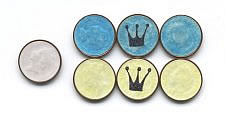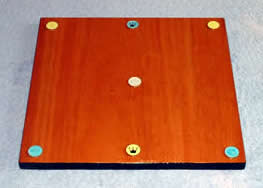Penny Blue - Be patient - True
THE EQUIPMENT

An Introduction
The Set
Winning by a Kill
Losing by a Mistake
Flicking
Side-flicks
Push Shots
More about Fouls
The Free Shot
Winning The Match
The game is for two players.
The eight counters used are called pennies. Except for their markings they are identical.
Each player has a team of three pennies. Two are marked as assassins and the other as a sovereign. Teams have contrasting colours.
One penny is called the blue (or bullet) and is usually coloured either light blue or white.
One penny is called the spare and is used only for measuring whether a side-flick can be allowed
The game should be played on a flat, square board, although it can be also be played on a hexagonal board.

A
set of Penny Blue coins - without the spare. UK 1p have been used. It
is usual to mark a sovereign with a crown.
"This game has the fewest rules and yet is the most difficult to play well. If you have no patience don't even think about it."
Each game begins with a set.
The blue is placed on the centre spot. The other pennies are placed on the outer spots as shown.
Notice that the two
sovereigns are placed opposite each other and that a player's pennies
must not be on adjacent spots.

To win a game with a kill you must flick one of your assassins so that the blue is made to collide with one or more of your opponent's pennies - assassins or the sovereign - in such a way that your opponent's sovereign is knocked off the board. All the other pennies must remain on the board. This is called a kill.
You cannot make a kill with your first turn of a new game. Note that the penny you flick doesn't have to hit the blue.
You lose the game by doing any of the following.
Knocking off the board your opponent's sovereign illegally.
Knocking off the board any penny other than your opponent's sovereign.
Committing a foul, which results in your opponent's sovereign coming off the board.
By flicking a penny so that it, or another penny, comes to rest either wholly or partially on top of, or underneath, one or more pennies. That's a stack. It's not allowed.
If you flick incorrectly you commit a foul.
You can flick only your own pennies. If you touch a penny that isn’t on your team then you have committed a foul.
You must flick cleanly with the nail of finger or thumb.There should be no nudging or double hitting and your hand should not move.
If the penny you flicked hits a penny - any penny at all - then you are allowed another flick. If it doesn't hit a penny then you lose your turn.
You are allowed a maximum of three flicks per turn.
"It's a different kind of a game than the others. It's a bit like chess. You know what I'm saying. If you go for the kill all the time a good player will trounce you. You've got to think two moves ahead. It's hard, man."
"I try to anticipate what my opponent will be able to do after my intended move. That's what makes it such a tough game. In Penny Black you make your break, and yeah, you have to think ahead to get the biggest break possible but you're not thinking about what your opponent is going to do, are you?"
"It took me a long time to get the hang of it. A very, very long time. And I'm still learning."
You cannot side-flick with an assassin. If the blue goes nearer to the edge of the board than a one-penny diameter then it may be side-flicked.
To test if the blue can be side-flicked place a ruler, or coin, or matchbox etc flat against the edge of the board next to the blue. Put the spare on the board so that it touches the ruler and slide it towards the blue.
Be careful to make
sure that the spare is always in contact with the ruler and that the ruler
is always in contact with the board.
If the spare touches the blue then the blue MUST be side-flicked.
To side-flick move the blue to the nearest point on the board's perimeter. Then make it overlap the board at that point in just the way you want it to.
Next, pick up your sovereign between a finger and thumb and hold it at the side of the blue. Use a finger on your other hand to help you flick the sovereign against the blue.
Afterwards the sovereign must be placed on a spot that is not already wholly or partially covered by another penny. A 'spotted' sovereign must never overlap the edge of the board.


"With one of my first two flicks I often knock the blue to the edge of the board so that I can make a side-flick. Then I can put my sovereign on a safe spot. It's a good tactic."
When you flick one penny at another which is near to it then, at the instant that the penny hits the other, your finger may still be in contact with the penny. If that is so then the flick is called a push shot
If
the original penny then strikes any other penny then the push shot is
a foul. If the original penny does not strike any other penny then
the push shot is legal. It is not a foul.

In the diagram shown it is impossible for the blue assassin to hit the bullet without being pushed through the red sovereign - a push shot.
If the blue assassin then hits the bullet (or any other penny) it would be a foul.
Moving the board so that one or more pennies slide makes a foul.
If a player commits a foul then he loses his turn and his opponent is awarded a free shot.
From a free shot it is not necessary to hit a penny in order to keep your turn.
A free shot does not increase the number of flicks. (E.g. you take your free shot and then have, potentially, three more flicks left.)
The first player to win an agreed number of games wins a set.
The first player to win an agreed number of sets wins the match